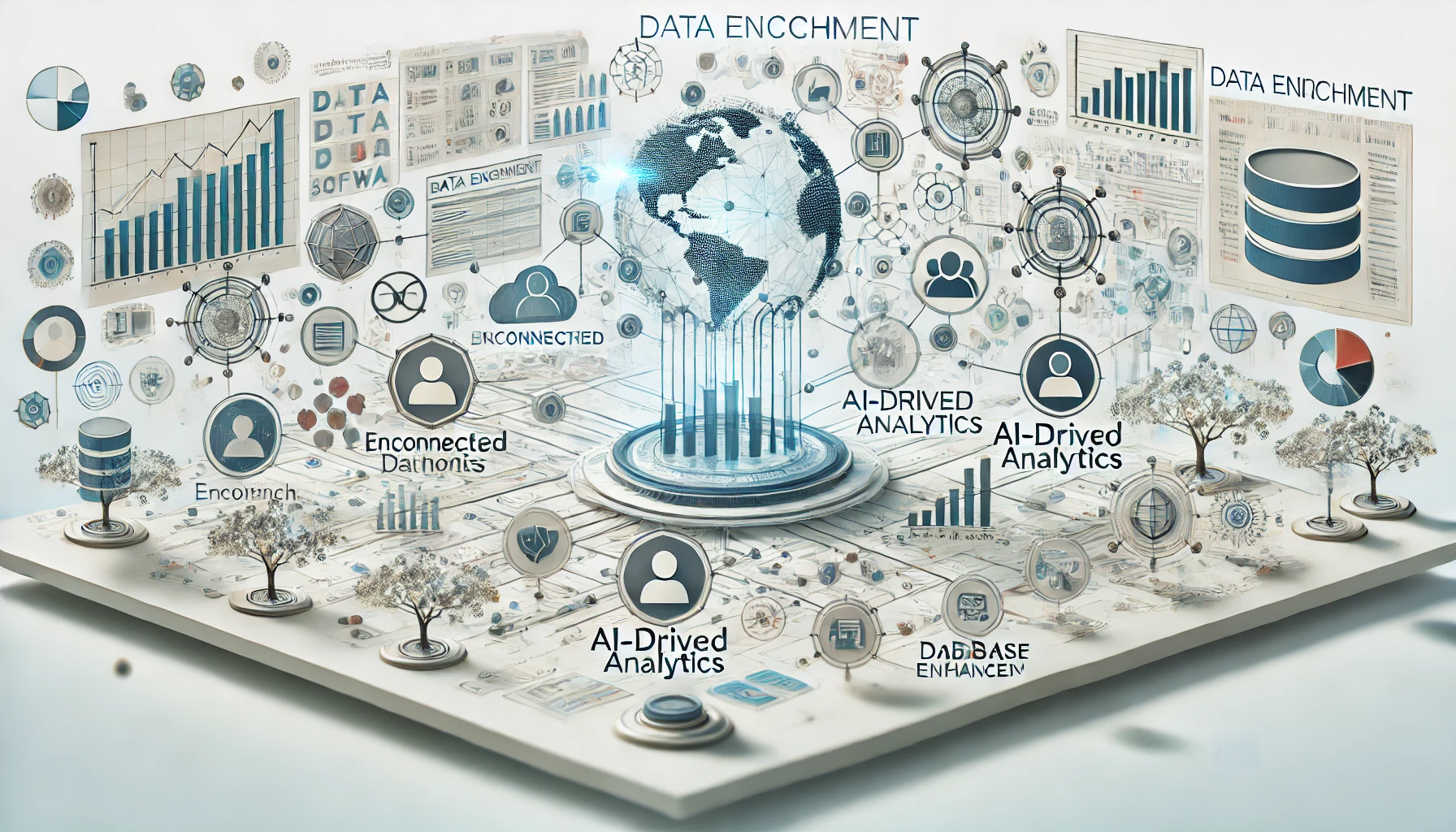Have you ever wondered what makes data enrichment software truly effective and indispensable? The key lies in understanding the ten essential elements that elevate its functionality and impact. From ensuring high-quality data to leveraging automation features and cloud-based systems, each element plays a crucial role in enhancing data enrichment processes. As we explore these elements further, you will discover how they collectively contribute to driving better decision-making and business success in today’s data-driven landscape.
High-Quality Data
When it comes to data enrichment software, one of the essential elements that cannot be overlooked is the presence of high-quality data. Data accuracy and data completeness are crucial components that determine the effectiveness of data enrichment processes. Data accuracy ensures that the information being added to existing datasets is correct and up-to-date, preventing errors and inconsistencies. Inaccurate data can lead to flawed insights and decisions, impacting the overall quality of data-driven strategies.
Moreover, data completeness is equally vital as it ensures that all relevant information is included in the enriched dataset. Missing or incomplete data can hamper the analysis and limit the utility of the enriched data. High-quality data sets the foundation for successful data enrichment, enabling organizations to derive meaningful insights and make informed decisions. By prioritizing data accuracy and completeness, data enrichment software can enhance the value of existing data assets and drive better outcomes for businesses.
Automation Capabilities
When it comes to data enrichment software, automation capabilities are crucial for efficient operations. Streamlined data processing helps you handle large volumes of information swiftly and accurately. AI-driven enrichment tools further enhance the accuracy and depth of your data, while seamless integration options ensure smooth collaboration with existing systems.
Streamlined Data Processing
To enhance efficiency and accuracy in data processing, the automation capabilities of data enrichment software play a pivotal role. Streamlined data processing is essential for managing vast amounts of information effectively. By automating repetitive tasks such as data cleansing, normalization, and enrichment, you can ensure enhanced accuracy and improved efficiency in your data workflows.
Automated data processing reduces the likelihood of human errors that may occur during manual data entry or manipulation. This not only saves time but also enhances the overall quality of your data. Streamlining data processing through automation allows you to focus on more strategic tasks that require human intervention, such as data analysis and decision-making.
Furthermore, automation enables data enrichment software to process large datasets quickly and consistently, ensuring that your information is always up-to-date and relevant. By leveraging automation capabilities, you can optimize your data processing workflows, minimize errors, and make more informed business decisions based on accurate and enriched data.
Ai-Driven Enrichment Tools
By harnessing artificial intelligence (AI) capabilities, data enrichment software empowers organizations to leverage advanced automation for enriching their datasets. AI algorithms play a crucial role in enhancing data accuracy by automatically identifying and correcting errors, inconsistencies, or missing information within the datasets. This not only saves time but also ensures that organizations are working with reliable and up-to-date data.
Moreover, AI-driven enrichment tools significantly boost enrichment efficiency through the use of machine learning. These tools can analyze vast amounts of data at high speeds, identifying patterns, relationships, and trends that might go unnoticed by manual processes. By automating the enrichment process using AI algorithms, organizations can quickly enrich their datasets with valuable information, leading to more informed decision-making and strategic insights.
Seamless Integration Options
Given the increasing complexity of data environments and the demand for streamlined processes, seamless integration options with robust automation capabilities are becoming paramount for organizations looking to maximize the efficiency and effectiveness of their data enrichment software. When considering integration options, system compatibility is crucial to ensure smooth data flow between different platforms, minimizing errors and enhancing data accuracy. Integration flexibility is equally important, allowing organizations to adapt the software to their specific needs and workflows. Customization options further enhance the integration process by enabling organizations to tailor the software to meet their unique requirements, optimizing the enrichment process. By choosing a data enrichment software with seamless integration options and robust automation capabilities, organizations can streamline their operations, improve data accuracy, and maximize the value extracted from their data assets. It is essential to prioritize these elements to ensure a seamless and efficient data enrichment process.
Data Integration
When it comes to data integration, your software needs to facilitate seamless data merging, ensuring that information from various sources can be consolidated effortlessly. Unified data sources are crucial for maintaining accuracy and consistency across your datasets, allowing for a more comprehensive view of your information. Efficient data mapping is essential for translating data from different formats and structures, enabling your system to understand and process information effectively.
Seamless Data Merging
To achieve comprehensive data enrichment, a crucial aspect that stands out is the seamless merging of disparate datasets, commonly referred to as data integration. Seamless data merging involves the efficient combination of various data sources, ensuring data synchronization and consolidation. This process eliminates data silos and inconsistencies, providing a unified view of information for analysis and decision-making.
Effective data merging requires robust algorithms and methodologies to match, link, and merge datasets accurately. By integrating data seamlessly, organizations can enhance data quality, reduce errors, and improve overall operational efficiency. Additionally, seamless data merging enables businesses to gain a holistic view of their data landscape, facilitating better insights and strategic planning.
Furthermore, automated data integration tools play a vital role in streamlining the merging process, saving time and resources. These tools enable the mapping of data fields, transformation of data formats, and scheduling of data synchronization tasks. Overall, seamless data merging is essential for unlocking the full potential of data enrichment efforts and driving informed business decisions.
Unified Data Sources
As you consider the complexities of data enrichment, the concept of Unified Data Sources, also known as Data Integration, emerges as a pivotal component in maximizing the value of your data assets. Data collaboration and consolidation are at the core of Unified Data Sources, enabling you to bring together information from various sources into a single, cohesive platform.
Data collaboration facilitates the sharing and integration of data from different departments or systems within your organization, breaking down silos and fostering a more holistic view of your data landscape. By harmonizing disparate data sets through data consolidation, you can eliminate redundancy, inconsistencies, and errors, leading to a more accurate and comprehensive understanding of your data.
Unified Data Sources not only streamline data access and management but also lay the foundation for more advanced data enrichment processes. By centralizing your data sources, you can create a solid groundwork for efficient data mapping and other enrichment activities, enhancing the overall quality and usefulness of your data assets.
Efficient Data Mapping
Efficiency in data mapping, a cornerstone of data integration, plays a pivotal role in optimizing the utilization of your data resources. Data accuracy is crucial in this process, ensuring that the mapped data is correct and reliable for analysis and decision-making. By employing efficient mapping techniques, you can enhance data enrichment, enriching your datasets with valuable information that can lead to more informed business strategies.
Effective data mapping techniques streamline the integration of various data sources, allowing for seamless data flow and compatibility. This not only saves time but also reduces the risk of errors that may arise from manual data mapping processes. Automated mapping tools can significantly improve mapping efficiency, enabling you to handle large volumes of data with precision and speed.
Furthermore, by implementing standardized mapping practices, you can ensure consistency across different datasets, promoting coherence and uniformity in your data enrichment processes. Overall, prioritizing efficient data mapping techniques can elevate the quality of your data enrichment efforts and drive better insights for your organization.
Data Validation
Enhancing the reliability and accuracy of your data is a fundamental aspect of data enrichment software. Data validation techniques play a crucial role in ensuring that your data is trustworthy and error-free. Through data quality assessment, you can identify and correct any inconsistencies, inaccuracies, or incompleteness in your datasets.
Various data validation techniques can be employed to enhance the quality of your data. These include validation rules, cross-field validation, format validation, and data profiling. Validation rules help in checking data against predefined criteria, ensuring it meets specific standards. Cross-field validation verifies relationships between different fields to maintain data coherence. Format validation ensures data is entered in the correct format, enhancing its consistency. Data profiling involves analyzing data to understand its structure, completeness, and accuracy.
Data Mapping
When it comes to data mapping, understanding the mapping process overview is crucial. By grasping the key mapping strategies, you can effectively navigate the complexities of data enrichment. These elements form the foundation for a successful data mapping approach.
Mapping Process Overview
To initiate the mapping process within data enrichment software, you first need to establish a systematic approach for aligning and connecting various data sources. The effectiveness of the data enrichment process heavily relies on the accuracy of mapping data sources. Data mapping involves the creation of relationships between different datasets, ensuring that information flows seamlessly and is properly integrated. By mapping data sources accurately, you can enhance the quality and relevance of your enriched data, enabling better insights and decision-making.
A crucial aspect of the mapping process is ensuring that the connections between data elements are precise and consistent. This helps in maintaining data integrity and reliability throughout the enrichment process. By meticulously mapping data sources, you can identify discrepancies, inconsistencies, and duplications, thereby improving the overall quality of your enriched data.
Key Mapping Strategies
Effective data mapping is a fundamental aspect of data enrichment software, essential for ensuring seamless integration and alignment of diverse datasets. When it comes to key mapping strategies, following mapping best practices is crucial for maintaining data quality. Additionally, focusing on mapping efficiency is essential for achieving optimal data accuracy. Here are four key strategies to consider:
- Comprehensive Data Analysis: Conduct a thorough analysis of all datasets involved to identify key relationships and dependencies for accurate mapping.
- Standardization of Mapping Procedures: Implement standardized mapping procedures to ensure consistency and reliability across all data integration processes.
- Regular Data Quality Checks: Establish a routine for conducting data quality checks to verify the accuracy of mapped data and address any discrepancies promptly.
- Continuous Monitoring and Optimization: Continuously monitor the mapping process and optimize mappings based on evolving data requirements to enhance data accuracy and alignment.
Reporting and Visualization
For data enrichment software, the capability of reporting and visualization plays a crucial role in extracting meaningful insights from the enriched data. Effective reporting best practices ensure that the enriched data is presented in a clear and concise manner, making it easier for you to identify trends, patterns, and anomalies. Utilizing data visualization techniques such as charts, graphs, and dashboards can help you interpret large datasets quickly and make informed decisions based on the enriched information.
When selecting data enrichment software, consider the reporting capabilities it offers. Look for features that allow you to customize reports, schedule automated report generation, and integrate with other tools for seamless data analysis. Visualization tools should provide interactive options for exploring data visually, enabling you to drill down into specific details and gain deeper insights.
Cloud-Based System
A cloud-based system offers scalability and flexibility for data enrichment processes, allowing businesses to efficiently manage and analyze vast amounts of data. When considering a cloud-based system for data enrichment software, it is crucial to prioritize aspects like data security and user experience to ensure optimal functionality and performance.
- Data Security: Cloud-based systems provide advanced security measures to safeguard sensitive data from unauthorized access or breaches, ensuring compliance with data protection regulations.
- Scalability: Cloud systems can easily scale resources up or down based on demand, enabling businesses to adapt to changing data processing needs efficiently.
- User Experience: Intuitive interfaces and seamless navigation in cloud-based systems enhance user experience, enabling smoother data enrichment workflows and increased productivity.
- Flexibility: Cloud systems offer the flexibility to access data enrichment tools from anywhere, promoting collaboration and remote work capabilities while maintaining data integrity and security.
Collaboration Features
As businesses increasingly rely on cloud-based systems for efficient data enrichment processes, the integration of collaboration features becomes paramount for enhancing team productivity and data accuracy. User engagement is crucial in ensuring that team members actively participate and contribute to the data enrichment process. Collaboration features such as real-time editing, commenting, and task assignment facilitate seamless communication and coordination among team members working on data enrichment tasks.
Effective communication tools within data enrichment software enable team members to discuss data interpretations, resolve discrepancies, and share insights in a centralized platform. Features like notification alerts, chat functionalities, and collaborative workspaces streamline information sharing and decision-making processes, leading to improved data quality and consistency.
Data Segmentation
Segmenting data is a critical process that involves categorizing information into distinct groups based on specific criteria or characteristics. Effective data segmentation plays a crucial role in enhancing data accuracy and enabling targeted marketing strategies. By dividing your data into relevant segments, you can personalize your marketing efforts and tailor your messages to specific audience groups. Here are four key aspects to consider when focusing on data segmentation:
- Data Accuracy: Ensure that the data used for segmentation is up-to-date and reliable to avoid errors in targeting your audience accurately.
- Targeted Marketing: Utilize segmented data to create personalized marketing campaigns that resonate with specific customer segments, increasing the likelihood of engagement and conversion.
- Segmentation Criteria: Define clear criteria for segmenting your data, such as demographics, purchase history, or behavior patterns, to ensure effective targeting.
- Dynamic Segmentation: Regularly review and update your segmentation strategies to adapt to changing market trends and customer preferences, maximizing the impact of your marketing efforts.
Data Cleansing
Data Cleansing is an essential process in data management that focuses on identifying and correcting inaccurate, incomplete, or irrelevant data within a dataset. Ensuring data accuracy is crucial for making informed business decisions and maintaining the integrity of your database. One key aspect of data cleansing is duplicate removal, where identical records are identified and eliminated to prevent redundancy and inconsistencies in your data.
By conducting data cleansing regularly, you can enhance the quality of your database, improve operational efficiency, and minimize errors in reporting and analysis. This process involves various techniques such as standardizing data formats, validating entries against predefined rules, and cross-referencing information across different sources.
Effective data cleansing not only enhances the overall quality of your data but also contributes to better decision-making and improved business outcomes. By investing time and resources in maintaining clean and accurate data, you can optimize your data management practices and drive success in your organization.
Frequently Asked Questions
How Does the Data Enrichment Software Ensure Data Privacy and Security?
To safeguard data privacy and security, data enrichment software employs robust encryption methods. User authentication protocols add an extra layer of protection. By encrypting data and verifying user identities, the software ensures that sensitive information remains secure.
Can the Software Handle Real-Time Data Enrichment Updates?
Yes, the software can handle real-time data enrichment updates ensuring data accuracy. It also offers scalability and performance optimization features. This allows you to efficiently enrich data continuously, keeping it up-to-date and relevant.
Is There a Limit to the Number of Data Sources That Can Be Integrated?
When considering the number of data sources for integration, ensure scalability limits are addressed. Flexibility in integration is key for success. Make sure the software can handle diverse sources efficiently without compromising performance.
Does the Software Support Custom Data Mapping Configurations?
Yes, the software supports custom data mapping configurations. You can easily set up personalized mappings through the user-friendly interface. Its scalable architecture ensures flexibility to accommodate varying data structures, enhancing overall data enrichment capabilities.
Are There Options for Customizing Reporting Templates in the Software?
Like an artist with a blank canvas, you can unleash your creativity with customization options in our software. Enjoy unparalleled reporting flexibility through customizable templates that cater to your unique needs and showcase data insights efficiently.




